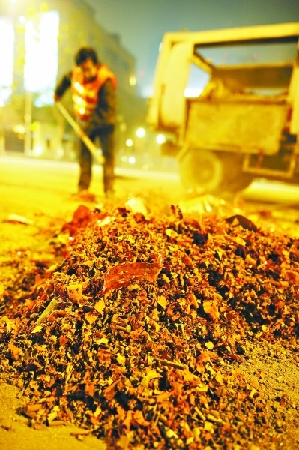Beijing firecracker spree results less waste
 0 Comment(s)
0 Comment(s) Print
Print E-mail China.org.cn, January 29, 2012
E-mail China.org.cn, January 29, 2012
 |
|
Firecrackers leave less waste in the Beijing |
Firecrackers lit by Beijing residents to celebrate Chinese New Year left 183.7 tonnes of paper scraps, according to the capital's environmental sanitation group yesterday. The figure was 3.09 tons less than in 2011.
More than 5,000 sweepers worked during the holiday to keep residential communities and streets clean, said Zhang Zhiqiang, a manager with the Beijing Environmental Sanitation Engineering Group.
The group also kept 20 water tank trailers on standby every day during the week of Jan. 22 to 28 in case of fires, as the Chinese Lunar New Year holiday is regarded as a season with a high occurrence of fires as a result of the firecracker spree, Zhang said.
On average, a family may spend hundreds of yuan on firecrackers during the Spring Festival, with some spending more than 10,000 yuan (US$1,582).
There were no statistics on how much firecracker waste was left in rural areas, where people are more enthusiastic in following the festival tradition and handle the waste themselves.
Meanwhile, firecrackers killed one person and injured more than 200 others, according to the municipal health bureau. The holiday firecracker casualties this year were down nearly 50 percent from a year earlier.
Nine of the injured remain hospitalized, the bureau said, without revealing any details about the only fatality.
Setting off firecrackers was believed to be an effective way to dispel misfortune and evils in ancient times, and thus became a must for the Chinese during major festivals and celebrations.
However, safety hazards caused by firecrackers became a major concern in China in the late 1980s, and 282 cities banned them successively in the 1990s, resulting in controversies as some complained that the centuries-old tradition would disappear if the ban continued.
People also complained that there had been a loss of festivity without the bangs of firecrackers.
Following suit with other cities, the Beijing municipal government lifted its 12-year ban on firecrackers in December 2005, but still restricts the locations and timing for igniting firecrackers.





